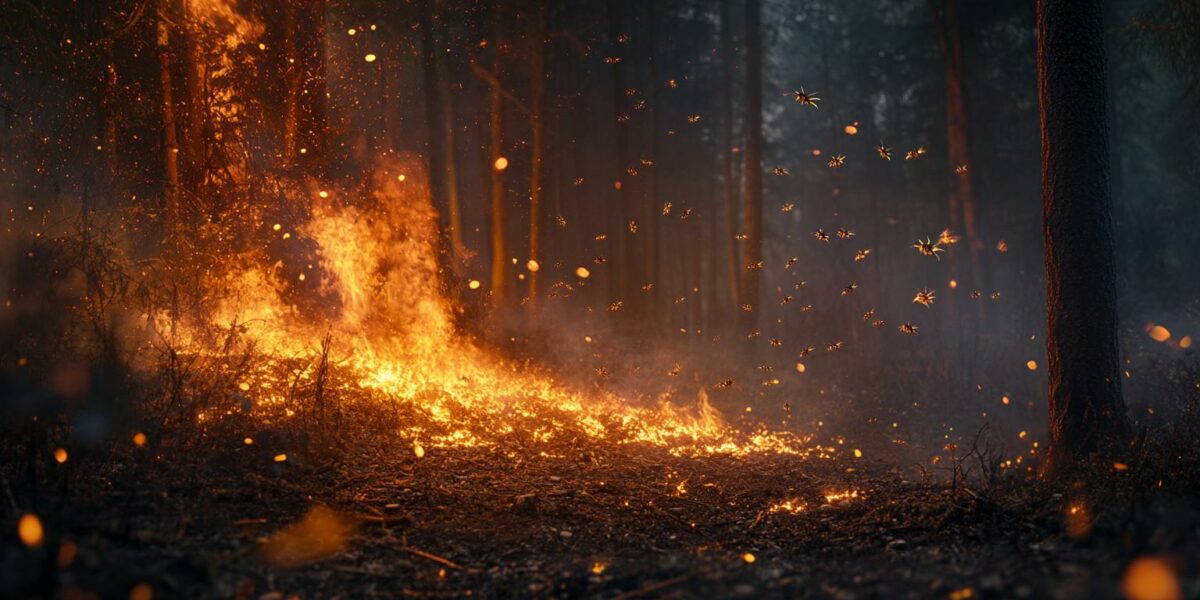Wildfire Frenzy: A Beetle’s Paradise
As wildfires rage across the western United States, thousands are fleeing their homes, but there’s one species that benefits: the Melanophila beetles. These small insects, about the size of pumpkin seeds, thrive on fire, using it for reproduction. They fly towards flames instead of away, copulating among the embers and laying eggs in the scorched wood.
Once the eggs hatch, the larvae feast on the freshly burned wood. This fiery breeding ground offers several advantages. Predators are scarce in these hot zones, giving the larvae a better chance of survival. Scientists believe this unique adaptation evolved as a survival tactic.
Climate change is extending wildfire seasons, creating more opportunities for these beetles. As our planet heats up, these adaptations remind us that not all creatures will suffer. Some, like the Melanophila beetles, are perfectly suited for this fiery future.
With their sensory pit organs, these beetles can detect infrared radiation, helping them locate fires from miles away. This incredible anatomy allows them to find flames and thrive in environments where most animals would perish.
Ingenious Infrared Sensing Abilities
Despite their unremarkable appearance, Melanophila beetles possess sophisticated anatomy. Their bodies are equipped with infrared sensors, similar to night-vision goggles, allowing them to detect heat from fires. These sensors, known as sensory pit organs, are located on the insects’ underside and guide them towards flames.
In addition to infrared sensors, their antennae may detect smoke. During the 1940s, Melanophila beetles swarmed football games at the University of California Berkeley, attracted by tobacco smoke. Researchers believe the smoke, rather than heat, drew them in.
These beetles can detect fires from incredible distances. A 2012 study suggested that they can sense large fires from up to 80 miles away, showcasing their remarkable ability to find flames. This means where there’s fire, there are usually Melanophila beetles.
Firefighters are well aware of this fact. According to entomologist Lynn Kimsey, wildland firefighters often encounter these beetles in large numbers. The beetles can even bite through firefighters’ gear, causing discomfort similar to a bee sting.
Scorched Earth: A Beetle’s Mating Haven
Male beetles flock to forest fires with one goal: to find a mate. These insects perch near burning wood or hot ashes, and when they locate a female, they copulate vigorously. The females lay their eggs under the bark of burnt trees, ensuring a safe environment for their offspring.
Why do they choose freshly burned forests? The simplest reason is that their larvae can only thrive on burned wood. Trees weakened by fire have fewer defenses, allowing the larvae to bore through the bark and feed easily. This environment provides a wood buffet and fewer insect predators.
Recently burned areas also have fewer competing insects, giving the larvae a better chance to grow and develop. Some evidence suggests that the heat from fires accelerates their growth, allowing the beetles to produce more offspring in less time.
In summary, freshly burned forests offer an ideal environment for these beetles. The larvae can feed freely, face less competition, and grow faster, making it a perfect breeding ground.
Climate Change: A Double-Edged Sword
Rising temperatures due to climate change are already impacting many species and ecosystems. Coral reefs are bleaching, hurricanes are intensifying, and some animals are struggling to adapt. However, for the Melanophila beetles, this warming trend might be beneficial.
Climate change is making wildfires more frequent and severe, creating more opportunities for these beetles to breed. Scientists suspect that these insects can only reproduce in the presence of fire, and the increasing number of wildfires may actually help their populations grow.
While this is still speculative, what is clear is that climate change will produce both winners and losers. The Melanophila beetles might be among the few species that thrive in a hotter, more fire-prone world. A planet on fire could be a paradise for these beetles.
In conclusion, as climate change reshapes our world, some species will find new opportunities to flourish. The Melanophila beetles may be one of the rare winners in this altered landscape, turning the devastation of wildfires into a thriving habitat.



Cleo
Could you provide more details on how climate change is affecting other insect species?
harrisonwhispering0
Thanks for the info. I had no idea any species could benefit from wildfires.
Isaiah
Haha, imagine beetles crashing a football game because of smoke! Nature is wild!
lillianphoenixfire
Do the beetles pose any threat to human structures or are they just a nuisance?
matthew
Great article, but it makes me wonder what happens to other wildlife in these burned areas?
gabriella
So interesting! How exactly do their infrared sensors work?
Caroline_Galaxy
Isn’t there a risk that these beetles could become invasive if wildfires increase even more?
AdrianFlare
Wow, who knew beetles could be so fascinating? Thanks for sharing this! 😊